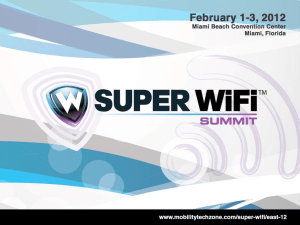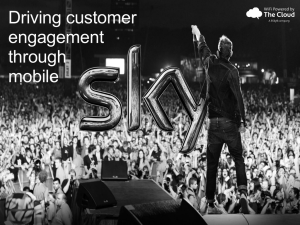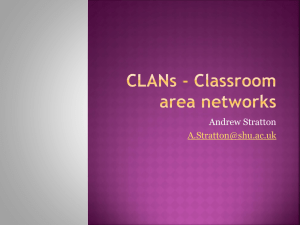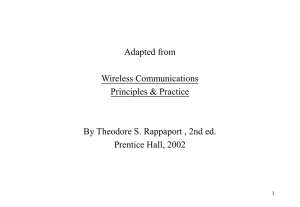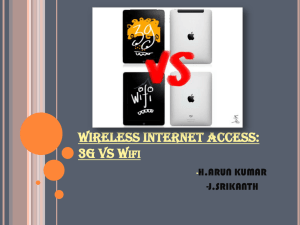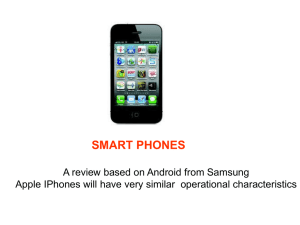Wireless Issues
advertisement
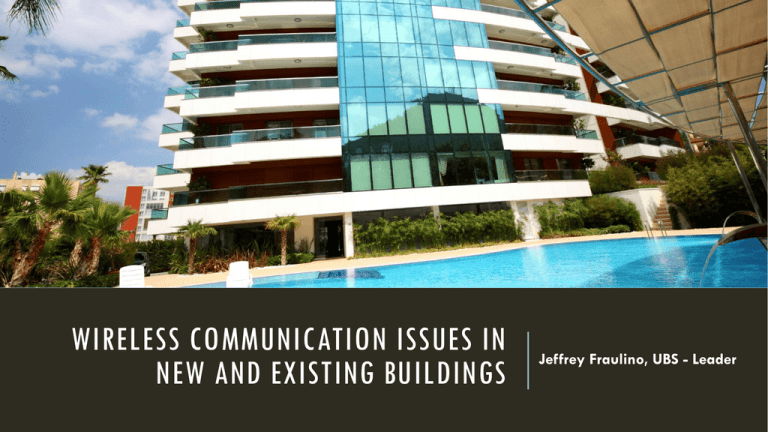
WIRELESS COMMUNICATION ISSUES IN NEW AND EXISTING BUILDINGS Jeffrey Fraulino, UBS - Leader PRESENTERS Rob Lopez is Senior Vice President at RCC Consultants, Inc. RCC Consultants is a global telecommunications engineering and consulting firm. Since 1983, we have helped more than 1,500 public and private sector clients around the world with their needs assessment, conceptual design, specifications, project and program management, procurement, funding, implementation, testing and operations needs Tom Doyle is President and Chief Operations Officer at Spot On Networks (SON). Spot On Networks provides inbuilding wireless solutions to the MDU/MTU market. Prior to joining Spot On, Tom spent 5 years at Motorola as Director of the Integrated Solutions Division and Manager of New York State Public Safety. TOPIC OVERVIEW • Definition of Types of wireless and some basic terminology • Importance of Providing Adequate Wireless Communications in MDU/ MTU Buildings • WiFi & Public Safety Radio & Cellular - What You Need To Know • Major Wireless Issues Facing MDU/ MTU Buildings and Solutions To Solve The Problem • Future Proofing Buildings WIRELESS ISSUES AND SOLUTIONS WIFI INDUSTRY TERMS 802.11 802.11 is commonly called by it’s trade name, Wi-Fi and refers to the IEEE’s wireless networking standard. 802.11n vs. 802.11ac 802.11ac, ratified in 2012 is the current generation of wireless networking standards defining a faster and more reliable Wi-Fi technology. WiFi Calling Wi-Fi Calling (or Voice-over-WiFi) is the name currently being used by carrier and device manufacturers to describe seamless calling that can roam between Wi-Fi and cellular networks using a device’s existing firmware. WIFI ISSUES • Expected Everywhere: Residents and tenants expect to have WiFi access everywhere they go for data offload and WiFi calling. • Reliability: In a high density area (like an apartment building, mall, business complex) multiple routers can cause signal interference resulting in instability and unreliability. • Security: Accessing secure WiFi is paramount. In high density buildings users need to be safe from hacking, spoofing and identity theft. • CALEA Compliance: The Communications Assistance for Law Enforcement Act mandates that building owners that provide WiFi access need to be able to provide access history in the event of a government subpoena. • Need for wireless backbone to support other in-building solutions. WIFI ISSUES… Outside deployments pose challenges with signal penetrating buildings. Was a problem with so-called “Municipal Networks” (Earthlink Philadelphia). Single family solution – everyone has their own router – doesn’t work in MDU/MTU. Interference problems. As an owner this will become an issue for you….”quiet enjoyment” provision. Building owner can manage WiFi frequencies in a building and provide services through an integrator. Can share in cellular data offload revenue. WIFI SOLUTIONS • Property-Wide Coverage: Residents and tenants expect to have WiFi access everywhere they go for data offload • Varies by building type: High rise, mid rise, garden style or campus • High Quality WiFi Services: QoS, SLA, Coverage, Reliability – necessary for Voice (though not currently guaranteed by WSPs) • Interference Mitigation: right design • Appropriate security: Access to secure WiFi is paramount. In high density buildings users need to be safe from hacking, spoofing and identity theft. • CALEA Compliant: The Communications Assistance for Law Enforcement Act mandates that building owners that provide WiFi access need to be able to provide access history in the event of a government subpoena. • Holistic Approach: A Wireless backbone that supports ancillary services: staff data services, customer service and other “bolt on” uses. FIRST RESPONDER RADIO INDUSTRY TERMS 700 / 800 MHz – The frequency bands typically reserved for trunked or shared operations using sophisticated access technologies designed for mission critical applications (ruthless preemption, man-down, talk-group (one-to-many communications), emergency calling with prioritization. VHF / UHF – Frequency licensed to Fire, Police and EMS personnel for their primary means of communicating with Dispatch and/or Incident Response Command. Delivered Audio Quality (DAQ) – A subjective measurement of the intelligibility of the received audio, e.g., DAQ 3.4. Coverage Reliability – A level of dependability in percent, e.g., 98%, to which a system will deliver and guarantee reception and transmission with respect to a signal level (-95dBm), DAQ 3.4 or both. NFPA 1221– The 2013 version of the National Fire Protection Agency (NFPA) code that is currently under review by committee. Proposed changes for 2016 include: DAS, DAQ will apply to analog FM and digital (e.g., P25) systems, battery backup for up to 4 hrs or greater. FIRST RESPONDER RADIO For building owners safety is paramount – first responder radio coverage is essential to ensure that first responders can communicate once inside your building. Many jurisdictions now mandate that building owners install equipment to boost the range of first responder radios inside of buildings – many buildings need to prove adequate first responder radio coverage prior to receiving a certificate of occupancy. First Responder coverage systems need to be designed and installed to met local codes. Unlike subscriber coverage, First Responder require coverage in stairwells, along hallways, in mechanical rooms with greater than 95% (intelligible) signal reliability. In 2012 there were 97,000 apartment fires in the U.S. RADIO ISSUES •LEED building materials block First Responder signals similar to cellular operations (800 Mhz vs. 1900 Mhz). •Licensing: Radio frequencies are licensed to the public safety municipalities that use them. •CO: Need first responder radio coverage to obtain certificate of occupancy •Ordinances by Municipal Fire Marshalls are becoming commonplace. RADIO SOLUTIONS •Site Survey: Site frequency plan to determine where first responder radio coverage is lacking •Code Compliance: Meet with local officials to determine ordinances and codes •Vendor Selection: Right equipment/price for building •Monitoring: Ongoing 24 x 7 monitoring of the system as required by local codes •Inspection: Periodic inspections and testing as required by local codes •Maintenance: Equipment Maintenance CELLULAR INDUSTRY TERMS 3G – Third Generation 3G is the short form for the “Third Generation” of mobile cellular technology. (First generation was analog cellular and the second was digital PCS). 3G technology was introduced in 2001 and gained widespread use in 2007. In order to meet standards, 3G must provide a peak data transfer rate of 2 Mbps and minimum consistent internet speeds of 144 Kbps). The actual technology varies with the most common being GSM or CDMA. 3G is used for voice telephony, mobile internet access, fixed wireless internet access, video calls and mobile TV. 4G – Fourth Generation 4G or fourth generation mobile cellular technology which allows for faster data transfer than 3G (launched in 2008). The speed standardization is not as specific as 3G, however in 2012 the average 4G speeds could range between 2.5 and 13 megabits. 4G technologies like Wi-Max, LTE and HSPA+ adopted the MIMO standard which allows cellphones to send and receive data across multiple frequencies resulting in faster speeds. 4G technology does not solve dropped calls or voice problems…it provides faster data transmissions. LTE – Long-Term Evolution LTE or long-term evolution is a 4G mobile communications standard. Some consider LTE to be the “true 4G”. LTE was initially adopted only by Verizon. With the success of LTE speed increases AT&T, Spring and T-Mobile began to build their own LTE networks. LTE is on average 10 times faster than 4G. CELLULAR ISSUES – IMPACT ON RESIDENTS AND TENANTS • MDU landlines have only a 17% take rate – 80% of apartment residents use their smartphone as their primary phone. At work, your customers are calling your cellphone. • Rental or lease value of property decreases when there is no cellular coverage: • Residents and companies won’t rent or lease without it. • Public Safety Issue: Limited 911 services put residents at risk. Most 911 calls are from cellular phones. • Cellular service is a must-have utility not an amenity. • Customer complaints to staff about a problem you did not create but are held accountable to solve. Negative reviews in social media spread fast. CELLULAR ISSUES – WHY? • Macrocell design – geared towards providing OUTDOOR coverage, does not factor inbuilding coverage - covers geography not users • Limited licensed frequencies utilized by carriers. • Example: A typical carrier has aprox. 100 MHz of available spectrum for an entire city compared to the 650 MHz WiFi band for each building. • LEED building designs – like Low-E glass. Can attenuate cellular signal by as much as 1000 times. • Density of users inside MDU/ MTU buildings – if cellular signal does penetrate construction, it is at the mercy of user density. CELLULAR SOLUTIONS – WHAT CAN YOU DO? • Consumer Grade Boosters: A consumer residential solution – not geared toward providing en-masse building coverage. Works best in residential, single-family homes. • Distributed Antenna System (DAS): A sophisticated, fiber-based solution that turns a building into a cell site. Very expensive, typically $1.50 - $3.50/ sq. ft. Provides near ubiquitous and simultaneous coverage for multiple WSPs, Public Safety and WiFi. • Small Cells: Provides service for one carrier, less expensive than DAS but more expensive than CellBoost. (ie Ericsson Dot) • Hybrid Das Relies on cellular signal being present outside of the building. Relies on industrial grade BDA’s. Uses outdoor donor antenna. Subject to WSP approval and FCC compliance. • WiFi Calling: No carrier approval – quick and inexpensive ($.40 per sq. ft). Holistic approach offering many building solutions and provides both coverage AND capacity. Sprint and T-Mobile support; AT&T and Verizon just announced it will support in 2015.. Quality of Service not currently guaranteed. IMPORTANCE OF CABLE FUTURE-PROOFING When should architects and engineers get involved? ASAP!!! WHAT SHOULD YOU DO? Structured Cabling plan. Conduit. Infrastructure – fiber, CAT6, coax investment. Single demarcation point. Connect buildings. Wireless problems in buildings are solved with wires. Consultant – high end buildings in major cities will probably need a DAS, which will require carrier approval. Lengthy process so the sooner vendor is engaged the better. Passive portions of the system (antennas, RF transmission lines, splitters and couplers and fiber) may designed and installed before finished walls and ceilings. Understand local ordinances for first responder requirements – consultant can help here. WiFi – WiFi calling support can potentially reduce need for DAS. AT&T and Verizon just announced they will support in 2015. DISCUSSION

